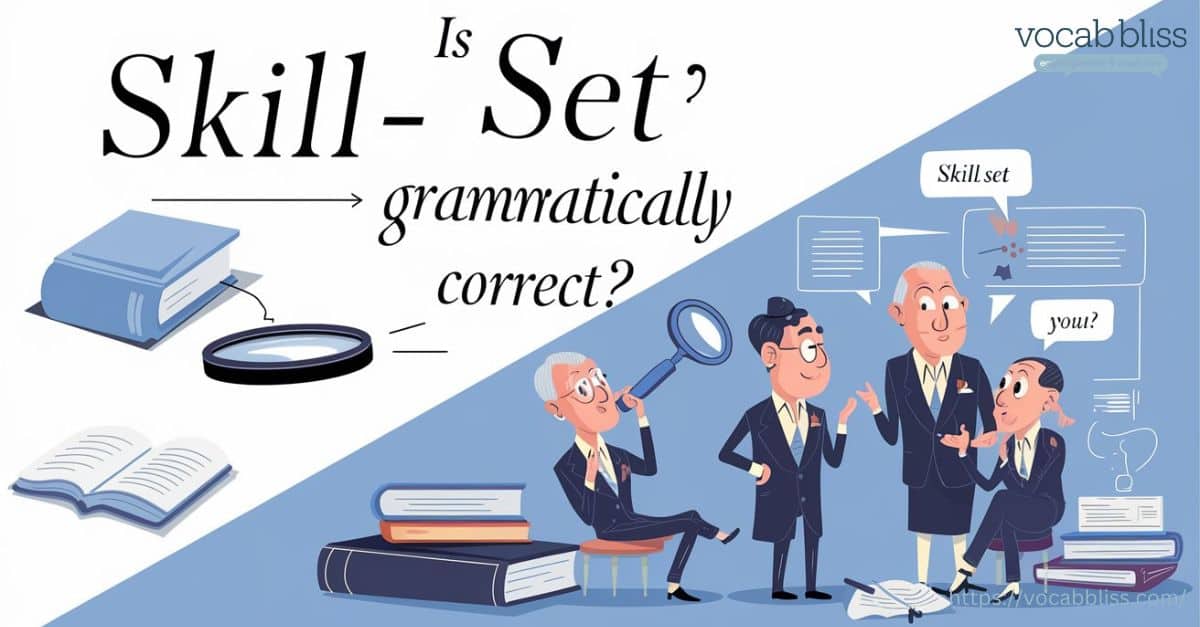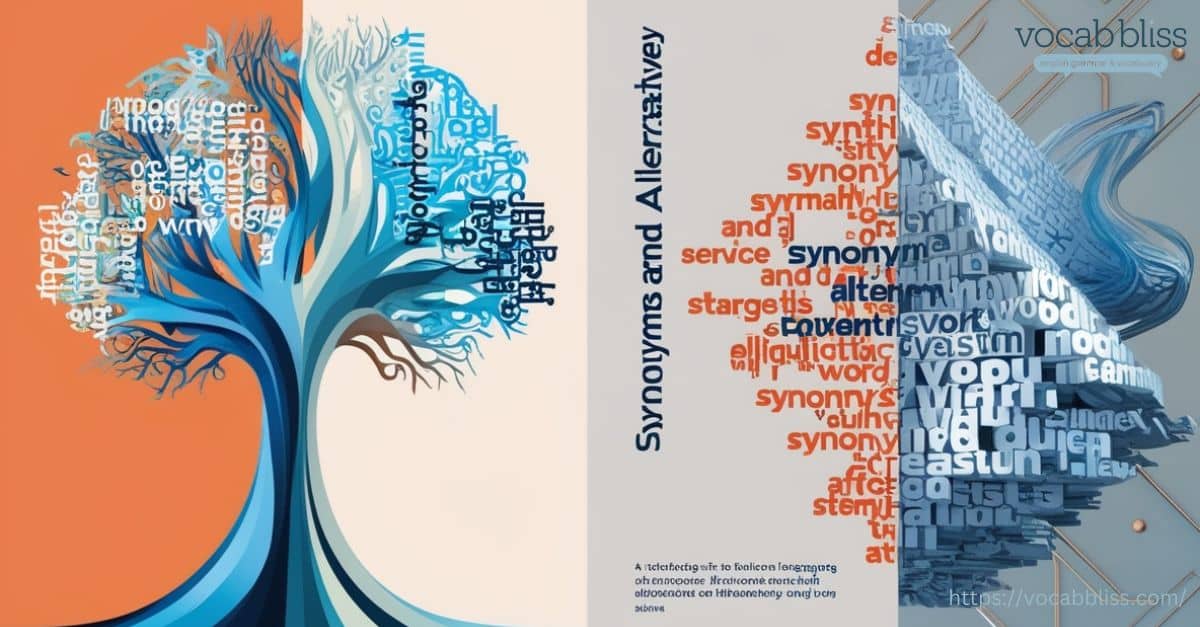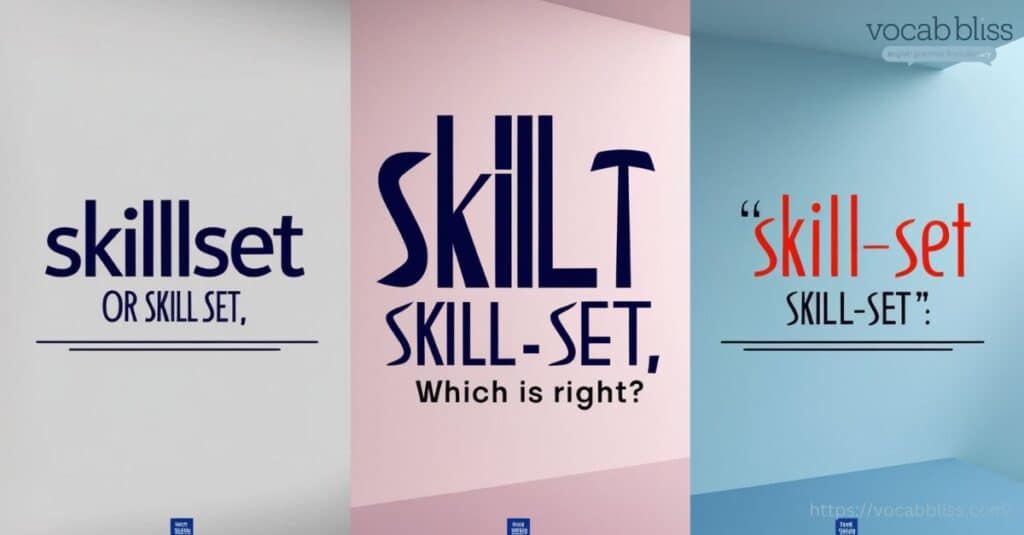Choosing the correct term between “skillset or skill set, Skill-Set” can be confusing, but understanding their differences is essential for clear, professional communication. Each variation has its own history, context, and proper usage.
In this guide, we’ll break down the distinctions, explore their origins, and provide practical advice on when to use each term.
Quick Summary
The debate between “skillset or skill set, Skill-Set” boils down to context, formality, and audience preferences. “Skill set” is the traditional, widely accepted form favored in academic and professional writing for its clarity and adherence to grammar rules. “Skillset,” a modern compound word, is increasingly popular in casual and digital contexts due to its brevity and efficiency. Meanwhile, “skill-set” is a largely outdated, hyphenated variation that rarely appears in contemporary writing. Understanding these distinctions ensures you choose the right form to suit your purpose, whether crafting resumes, job descriptions, or formal reports.
Discover more: In route or en route: Which choice is correct?
Why Is There Confusion Around These Terms?
The debate between “skill set,” “skillset,” and “skill-set” is rooted in the complexities of the English language. As words evolve and communication styles change, it’s no surprise that people often struggle to determine the correct form. Let’s explore the main reasons behind the confusion:
Overview of Common Misconceptions
- Interchangeable Usage: Many believe these terms are identical in meaning and can be used freely, but context matters. For instance, “skill set” is formal, while “skillset” is more casual.
- Assumption of Modernity: Some assume the single-word form, “skillset,” is more modern and therefore preferable. While it’s increasingly popular, it isn’t always the correct choice.
- Hyphenation Misuse: The hyphenated “skill-set” appears sparingly in older texts or as a stylistic anomaly. Its infrequent use contributes to confusion about its relevance today.
The Evolution of Language and Its Impact on Spelling Variations
English is constantly adapting to new trends and cultural influences, which shapes how words are spelled and used:
- From Open to Closed Compounds: Words like “skill set” often begin as two distinct terms (open compound), then transition to a hyphenated form (e.g., “skill-set”), and finally merge into a single word (closed compound) like “skillset.” This evolution mirrors changes seen in words like “e-mail” to “email” or “on-line” to “online.”
- Influence of Digital Communication: The internet and texting culture have encouraged shorter, more efficient word forms. As a result, “skillset” has gained traction in resumes, LinkedIn profiles, and informal writing.
Influence of Informal vs. Formal Communication
Another significant factor is the growing divide between formal and informal communication styles:
- Formal Contexts: Academic papers, corporate reports, and official documents favor the traditional “skill set” for its clarity and adherence to established grammar rules.
- Informal Settings: Social media posts, blogs, and everyday emails often use “skillset” for its brevity and modern appeal.
The choice ultimately depends on context, audience, and the tone you want to convey. By understanding these factors, you’ll navigate the complexities of these terms with confidence.
Defining “Skillset”

“Skillset” has become a widely accepted term in professional and corporate communication. As a single noun, it represents the collection of skills or abilities that a person possesses, particularly those relevant to a specific role or field. Its compact structure makes it ideal for modern, fast-paced writing, where brevity is valued.
Explanation of “Skillset” as a Single Noun
At its core, “skillset” is a streamlined way to refer to an individual’s competencies. It functions as a collective noun, much like “toolkit” or “mindset.”
- Why it works: Combining “skill” and “set” into one word eliminates unnecessary space, creating a term that feels more cohesive and modern.
- Commonality: “Skillset” is often used in informal or semi-formal contexts, such as resumes, job descriptions, and marketing materials.
For example:
- “The candidate’s skillset aligns perfectly with the requirements of the role.”
- “Enhancing your skillset can improve your career prospects.”
Usage Trends in Professional and Corporate Contexts
The rise of “skillset” corresponds with changes in workplace communication styles. Here’s why it thrives in professional settings:
- Efficiency: Corporate writing often prioritizes concise language. Using “skillset” instead of “skill set” saves space without sacrificing meaning.
- Digital Influence: Online job boards, LinkedIn profiles, and recruitment platforms favor shorter terms that are quick to read and scan.
- Adoption by Industry Leaders: High-profile companies frequently use “skillset” in job postings and employee development materials. This reinforces its legitimacy and popularity.
Examples from Job Descriptions and Resumes
The term “skillset” is especially prevalent in recruitment and HR-related documents. Here are some real-world examples of how it appears:
Job Descriptions:
- “We are seeking a project manager with a diverse skillset in budgeting, team leadership, and risk assessment.”
- “A strong skillset in data analysis and programming is essential for this role.”
Resumes:
- “My skillset includes expertise in graphic design, client relations, and social media strategy.”
- “Leveraging a comprehensive skillset, I have successfully managed cross-functional teams to deliver key projects on time.”
Breaking Down “Skill Set” as Two Words

“Skill set” remains the most widely accepted and traditional form, particularly in formal writing. As two separate words, it emphasizes the collective nature of individual skills grouped together for a specific purpose. This form is preferred in contexts requiring clarity and precision.
Definition and Proper Usage of “Skill Set”
At its core, “skill set” refers to a collection of abilities or competencies a person possesses. The open-compound structure clearly conveys that the term describes “a set of skills.”
- Why use two words? The separation of “skill” and “set” maintains formal tone and clarity, especially in structured documents.
- Universality: Unlike its alternatives, “skill set” is universally recognized and accepted across all contexts, making it a safer choice in professional communication.
For example:
- “Her skill set includes advanced statistical analysis and problem-solving.”
- “Developing a robust skill set is critical for career growth.”
Contexts Where “Skill Set” Is the Preferred Term
Certain scenarios demand the formal and precise tone of “skill set.” Here’s where it’s most suitable:
Academic Writing
In research papers, dissertations, and other scholarly works, “skill set” provides a clear and unambiguous term. It adheres to the formal standards expected in academia.
- Example: “The study evaluates the impact of a comprehensive skill set on job performance.”
Formal Documents
Official reports, business proposals, and technical manuals prefer “skill set” for its professionalism and adherence to traditional grammar rules.
- Example: “Employees are encouraged to expand their skill set through ongoing training programs.”
Style Guides
Most grammar and style authorities, including the AP Stylebook and Chicago Manual of Style, endorse “skill set” as the standard form. This makes it the go-to choice for writers aiming to follow established guidelines.
Examples from Academic Writing and Formal Documents
To illustrate how “skill set” is used in structured writing, consider the following examples:
Academic Contexts:
- “The development of a teacher’s skill set is essential for effective classroom management.”
- “A comprehensive skill set in both qualitative and quantitative methods strengthens research outcomes.”
Professional Reports:
- “A tailored training program can enhance the skill set of employees in leadership roles.”
- “The report highlights the critical skill set required to navigate global economic challenges.”
““Skill-Set Skill Set vs Skillset”: Which is Right?”: Understanding the Key Differences
Deciding between “skillset or skill set“ depends on factors like formality, audience, and the tone of your communication. While these terms refer to the same concept—a collection of skills—they convey subtly different nuances. Understanding these differences ensures that you use the right term in the right context.
Comparison of Usage Based on Formality and Context
| Aspect | Skill Set | Skillset |
|---|---|---|
| Formality | Highly formal; suitable for academic, legal, or professional documents. | Less formal; used in casual, digital, or semi-professional settings. |
| Tone | Precise and traditional. | Modern and conversational. |
| Common Contexts | Academic papers, corporate reports, official communications. | Resumes, job postings, informal articles, online content. |
| Preferred By | Grammar purists, traditionalists, style guides. | Digital platforms, recruiters, and younger audiences. |
For example:
- “Skill Set”: “The organization values employees with a diverse skill set in leadership and project management.”
- “Skillset”: “Her skillset in design and branding is a perfect match for this role.”
Common Pitfalls When Choosing One Over the Other
- Misjudging the Audience:
- Using “skillset” in a formal report can come across as too casual or unpolished.
- Similarly, opting for “skill set” in a social media post might feel overly stiff.
- Ignoring Style Guides:
- If you’re writing for an organization that follows the AP Stylebook or Chicago Manual of Style, “skill set” is almost always the recommended form.
- Overlooking Regional Preferences:
- In some regions, like the U.S., “skillset” is increasingly common in professional settings, but it may still appear non-standard in countries with stricter adherence to traditional English grammar rules, like the UK.
Making the Right Choice
To decide which form to use:
- Ask yourself: Is the document formal or informal?
- Consider the context: Are you writing a job posting, a blog, or an academic paper?
- Review your audience: Will they value tradition, or are they open to modern expressions?
What About “Skill-Set” (Hyphenated)?
Is skill set hyphenated form, “skill-set,” is the least common of the three variations. While it occasionally appears in older texts or specific writing styles, it’s generally considered non-standard today. Still, understanding its origins and where it might still be used can clarify its role in modern English.
Exploration of the Less Common Hyphenated Form
The hyphenated form “skill-set” likely emerged as an intermediate step in the evolution of the term, following the pattern of many compound nouns. Language often transitions through stages, from open compounds (e.g., “skill set”) to hyphenated forms, and eventually to closed compounds (e.g., “skillset”).
- Historical Use: The hyphen was historically added for readability, especially in lengthy sentences or complex structures where “skill” and “set” might otherwise be misinterpreted as separate ideas.
- Obsolescence: Over time, as “skill set” became more widely understood and accepted, the hyphen became unnecessary. Modern grammar trends favor simplicity, leading to the decline of “skill-set.”
Scenarios Where “Skill-Set” Might Appear
Although rare, there are scenarios where “skill-set” might still be used:
- Legacy Documents: Older business or academic texts, especially those written during periods when hyphenated forms were more common, might include “skill-set.”
- Example: “A well-rounded skill-set is critical for success in this role.”
- Stylistic Choice: Some writers or publications might prefer the hyphen for visual balance or stylistic emphasis, though this is less frequent.
- Example: “Her skill-set was both unique and comprehensive.”
- Non-Native English Use: Writers unfamiliar with English grammar norms may insert a hyphen to clarify the term’s meaning or structure.
Is “Skill-Set” Grammatically Correct?

Technically, “skill-set” is not grammatically incorrect. English allows for flexibility in compound word formation, and hyphenation is often a matter of preference or clarity rather than strict rule. However, most style guides, including the AP Stylebook and Chicago Manual of Style, do not endorse “skill-set.”
When to Avoid It:
- Formal Writing: Using “skill-set” in academic or professional contexts may appear outdated or overly complex.
- Consistency Issues: Mixing forms (e.g., alternating between “skill-set” and “skillset”) within a single piece can confuse readers.
The Verdict on “Skill-Set”
While “skill-set” occasionally appears, it is largely a relic of older writing conventions. Opt for “skill set” in formal contexts or “skillset” in modern, casual writing to align with contemporary grammar norms and audience expectations. If clarity is a concern, the open compound “skill set” remains the safest and most widely accepted choice.
Historical Usage of “Skill Set” and “Skillset”
The terms “skill set” and “skillset” have roots in the mid-20th century, but their popularity diverged over time:
- “Skill Set”: The original form, dating back to the 1950s, reflected formal writing norms.
- “Skillset”: Gained traction in the 1990s with the rise of digital communication and casual writing.
Historical Trends:
| Decade | Dominant Form | Example Usage |
|---|---|---|
| 1950s-1980s | Skill Set | “A solid skill set is necessary for leadership roles.” |
| 1990s-Present | Skillset | “Developing a strong skillset is key to career growth.” |
Regional Preferences in Spelling and Usage
English-speaking regions often differ in their linguistic preferences:
- American English: Both “skillset” and “skill set” are common, but the former is rising in popularity.
- British English: “Skill set” remains the preferred form in formal contexts.
- Global Trends: Technology industries worldwide favor “skillset” for its brevity.
Expert Opinions: Grammar and Style Guides on “Skill Set”
Major grammar and style guides provide varying recommendations:
- AP Stylebook: Endorses “skill set” for formal use.
- Chicago Manual of Style: Recognizes “skill set” as standard, discouraging the hyphenated form.
- Merriam-Webster: Includes “skillset” as a valid alternative, noting its informal tone.
Grammar Tips:
- Use “skill set” in academic or technical writing to align with grammar rules.
- Opt for “skillset” in conversational or marketing content.
How Public Perception Shapes Language Trends
Language evolves through collective use, and public perception plays a significant role in solidifying trends:
- Social Media Influence: Platforms like LinkedIn popularize “skillset” in professional networking.
- Industry Jargon: Sectors like IT and marketing often adopt shorter terms for convenience.
Examples of “Skillset” or “Skill Set” in Real Contexts
Job Postings:
- “Candidates must have a comprehensive skill set in software development.”
- “The ideal applicant brings a diverse skillset to the team.”

Academic Writing:
- “Developing a relevant skill set is critical for long-term success.”
Informal Communication:
- “I’m updating my skillset for the new role.”
Synonyms and Alternatives to “skillset or skill set”

When variety is needed, consider these alternatives:
| Term | Usage |
|---|---|
| Competencies | Broader scope, often used in HR contexts. |
| Expertise | Highlights depth of knowledge in specific areas. |
| Proficiencies | Indicates advanced skills or abilities. |
| Abilities | General term for innate or learned capabilities. |
Conclusion: Choosing the Right Term for Your Context
When deciding between “skill set, skillset or skill set,” think about your audience and purpose.
- Use “skill set” for formal or technical writing.
- Choose “skillset” for informal, modern, or concise communication.
- Avoid “skill-set” unless referencing older materials.
By understanding these distinctions, you’ll ensure your grammar is precise, your writing polished, and your message clear.
Continue reading:
- Sueing or Suing? Choose the Right Term
- Appendices or Appendixes? Clarifying Usage
- Busses or Buses: Clarifying the Plural Form of “Bus”
- Lier or Liar: Picking the Right Word

Jorge Phillips is an experienced blogger who writes for Vocab Bliss, sharing his passion for the English language. With a knack for simplifying complex grammar rules and a focus on commonly confused words, Jorge helps readers navigate the nuances of English with ease. His insights aim to make learning engaging and practical.







